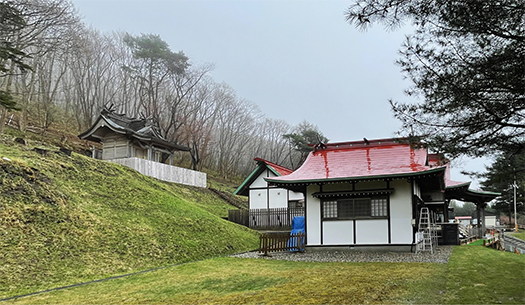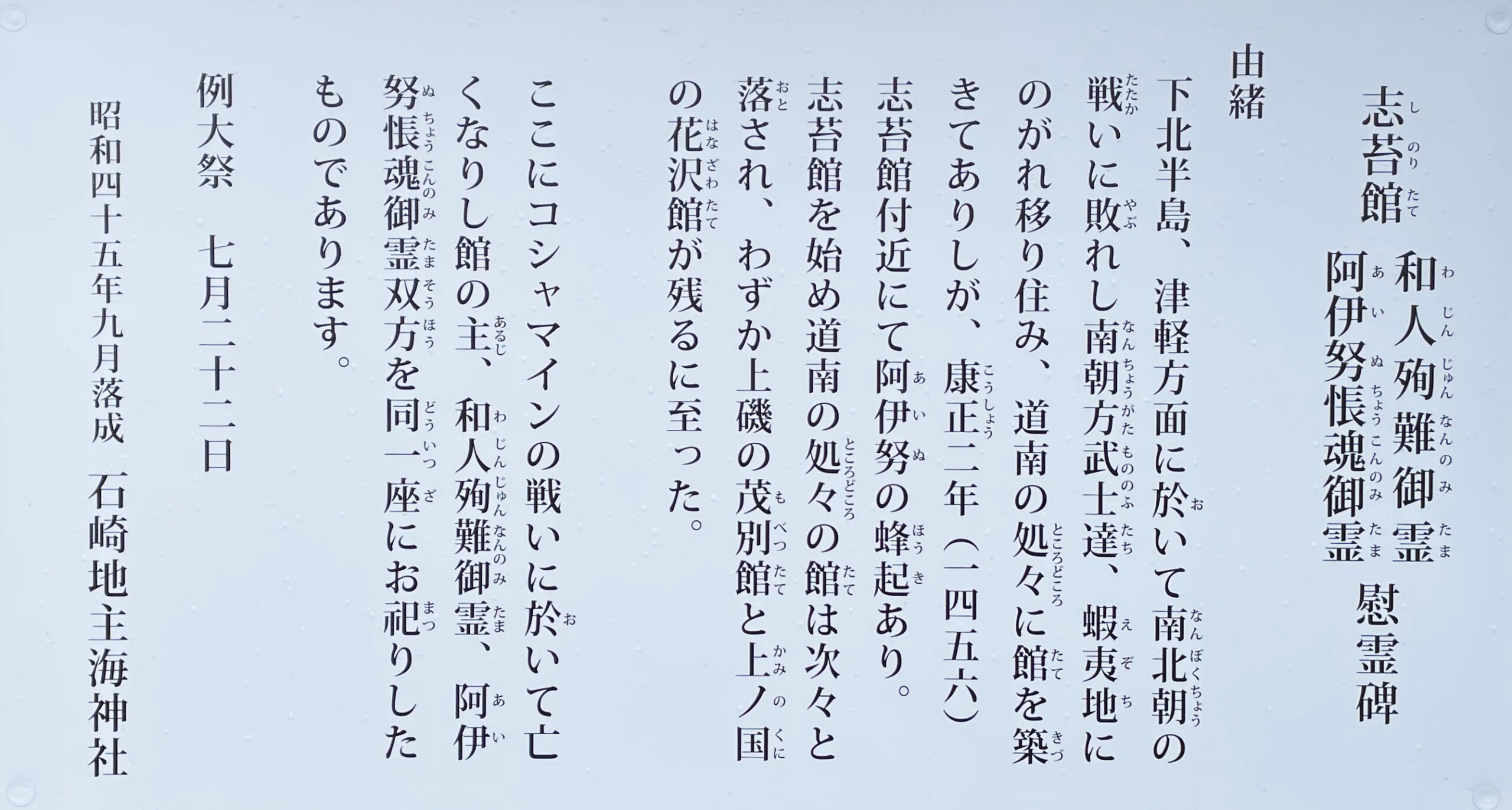

昨日、ようやく環境にやや落ち着きが出たので、懸案になっていた「道南十二館・志苔館」の小林氏についての論考を再開した。予定があってカミさんと十勝へ往復することになっていたので、大急ぎになってしまって文章の「校正」までとてもできず、わかりにくい点もあり要旨だけ書いたようなことだったのですが、末尾に「北海道が舞台になる日本中世史、当事者側意識も刺激されるので、興味を持って忍耐強く探究したいと思っております。読者のみなさんからも情報があれば、ぜひお教えください。」と呼びかけたところ、多くのみなさんからご賛同いただき、多くの情報をいただいた。以下、主なものを上げてみたい。(一応仮名にしています。)
①まず今回の道南十二館シリーズに応援メッセージをいただいていた秋田の建築家・Nさん。
「中世に西出羽・西津軽・渡島半島を支配した蝦夷(エゾ)管領の安東氏(安藤氏)は蝦夷(エミシ)奥州藤原氏の流れにあります。その一族の150年にわたった本拠地の大規模な館が私がいる能代にあります。檜山安東氏(安藤氏)です。中世からとんで幕末の蝦夷(エゾ)の陣屋も興味があります。」〜わたしのきのうの記事では奥州藤原氏と安藤氏は「関連がある」というようにぼかしていましたが、内心としてはまったく同意。北海道島人にとって秋田県北部地域は、実際に各地を歩いてみて、どうもある意味で「マザー」の雰囲気が強いと感じています。
②つづいてAさんから。「奥州藤原氏征伐には明確な大義名分が見当たらない気がします。大軍を組織するには たとえフェイクや言いがかりであっても大義名分が必要。」という歴史事実への怒りの一発。まったくその通りですが、関東武士団というのは巨大な私設暴力集団であって十分な倫理意識は醸成されていなかった段階。まぁ歴史はあるがまま受け取るしかないかと。
③いつも貴重なご意見コメントをいただくS.Nさんからは
「中世は物流とその安全を担保する警察(軍事)の時代でもある。平安末期に禁裏公家との妥協で生まれた国家警察たる鎌倉政権は、承久の変を経て確固たるものとなったかのように見えた。しかし元寇後、御恩奉公の原則が破綻すると荘園領主や幕府の支配が動揺し、従来の枠組みに対抗する悪党が登場した。悪党は武家社会を鎌倉的な中央集権的な枠組みから室町的・戦国的な群雄割拠の枠組みへと変容させるにあたって重要な役割を果たす。志苔館の小林氏もそういった悪党が交易・運輸の活動の場を求めて京から離れた陸奥・蝦夷で一旗あげたということではないかと想像する。」という長文の私説を開示いただいた。
これは非常にユニークな視点、中世の「元寇(1274年・1281年)後の武家心理」から「悪党」の発生を見て、そういった視点から南北朝対立(1336〜1392年)の状況を俯瞰する視点。
確かにわれわれ現代人は、社会制度とか体制が確立している、そのなかで人は生きるという先入観念にとらわれるけれど、このような社会の雰囲気の中で中世武士の「婆娑羅」心理にも通じるような行動原理がかれらの中にあった可能性も高いと思わされた。
またそのほか、滋賀民俗学会理事 城郭研究家のHHさんなどから「応援」コールも寄せられていました。みなさん多少の誤記や校正未了の件については受忍していただいて(笑)、そんな枝葉末節よりも「中世北海道島と武士団」という根本的な問題提起、解明すべきポイントについて同意・応援の気持ちを示されたものと感激していました。現地での体験記憶をベースに今後もすこしづつ牛歩してみたいと思います。みなさんありがとうございます。
English version⬇
Shikokukan Kankeishi, Medieval Southern Court “Kobayashi Clan” Clarification, Supporting Voices
The medieval island of Hokkaido and the fluctuations of the Japanese samurai ruling system. As a Hokkaido-er, I feel that my relationship with Japanese history has deepened by about 800 years. …
Yesterday, when things finally calmed down a bit, I resumed my long-awaited essay on Mr. Kobayashi of the “Donan Jujikan/Shikokan”. Since I had to go back and forth to Tokachi with my wife due to our schedule, I was in a great hurry and could not even “proofread” the text, so I wrote only the gist of the article due to some points that were difficult to understand. I would like to explore it with interest and patience. If you, the readers, have any information, please let me know. Many of you agreed and we received a lot of information. The following is a list of the main ones. (I have used pseudonyms in case you are interested.)
First of all, Mr. N., an architect from Akita, who sent us a message of support for the “Twelve Buildings in Southern Hokkaido” series.
First of all, Mr. N., an architect from Akita, who sent us a message of support for our series on the Twelve Buildings of Donan: “The Ando clan of the Ezo clan, who ruled the Western Izu, Western Tsugaru, and Watari Peninsula in the Middle Ages, are descended from the Oshu Fujiwara clan of the Ezo clan. The family’s large mansion, which was their headquarters for 150 years, is located in Noshiro, where I am located. It is the Hiyama Ando clan (Ando clan). I am also interested in the camps of the Ezo clan in the Middle Ages and the end of the Edo period. 〜I agree with you, although my article yesterday blurred the connection between the Oshu Fujiwara and Ando clans as if they were “related”. I have actually walked around the northern part of Akita Prefecture, and I feel that the area has a strong “mother” atmosphere for Hokkaido Islanders in some sense.
Next, we have Mr. A. I don’t think there is a clear cause for the conquest of the Fujiwara clan in Oshu. To organize a large army, you need a cause, even if it is a fake or false accusation. This is a shot of anger at the historical facts. This is absolutely true, but the Kanto Bushidan was a huge private violent group that had not yet developed a sufficient sense of ethics. I think we have to accept history as it is.
Mr. S.N., who always gives us valuable comments and opinions, wrote
The medieval period was also the era of logistics and the police (military) that ensured its security. The Kamakura regime, which was born at the end of the Heian period as a national police force through a compromise with the court nobles of the Forbidden Imperial Palace, seemed to have been firmly established after the Jokyu Incident. However, after the Genko Incident, the collapse of the principle of goenbougo (gratitude and devotion) upset the rule of manorial lords and the shogunate, and rogue elements emerged to challenge the traditional framework. Rogue clans played an important role in the transformation of samurai society from a centralized Kamakura-style framework to a Muromachi and Sengoku-style framework of rivalry among warring factions. I imagine that Mr. Kobayashi of Shikokan was one such scoundrel who, in search of a place to engage in trading and transportation activities, established himself in Mutsu and Emishi, far from Kyoto. This is a very unique point of view.
This is a very unique viewpoint, a viewpoint that looks at the emergence of “rogues” from the medieval “samurai psychology after the Genko (1274/1281),” and from such a viewpoint looks at the situation of the conflict between the Northern and Southern Dynasties (1336-1392) from a bird’s eye view.
It is true that we modern people have a preconceived notion that people live within an established social system, but it is highly possible that the medieval samurai had a principle of action in this social atmosphere that could be understood as a “basara” psychology.
In addition, we received “support” calls from Mr. HH, a castle researcher and director of the Shiga Folklore Society, and others. I was thrilled that everyone accepted the slight errors and incomplete proofreading (laugh) and expressed their agreement and support for the fundamental issue of “medieval Hokkaido Island and warrior groups” and the points to be clarified, rather than such trivial details. I would like to continue to cowpoke a little more in the future based on my memories of my experiences in the area. Thank you all.
Posted on 5月 5th, 2024 by 三木 奎吾
Filed under: 歴史探訪







コメントを投稿
「※誹謗中傷や、悪意のある書き込み、営利目的などのコメントを防ぐために、投稿された全てのコメントは一時的に保留されますのでご了承ください。」
You must be logged in to post a comment.